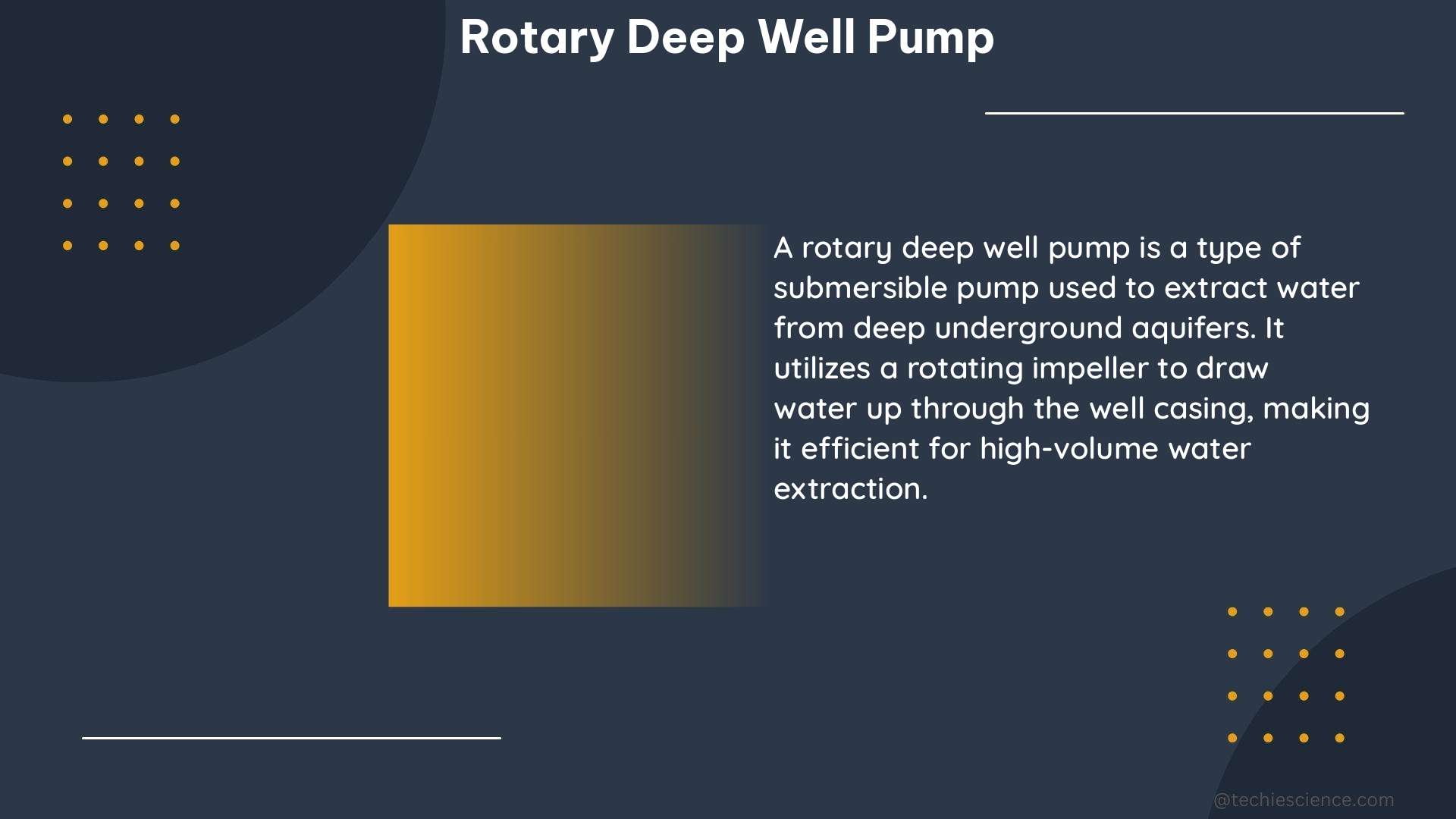Rotary deep well pumps are a specialized type of water pump designed to extract water from wells that are 50 feet or deeper. These robust and efficient pumps are renowned for their ability to handle high volumes of water while maintaining exceptional durability. In this comprehensive guide, we’ll delve into the technical details, performance metrics, and maintenance requirements of rotary deep well pumps, providing you with a valuable resource for understanding and maintaining these essential water-extraction systems.
Understanding Rotary Deep Well Pumps
Rotary deep well pumps are a type of submersible pump that utilizes a rotating impeller to draw water from the well and deliver it to the surface. These pumps are engineered to operate at depths ranging from 50 to 4,000 feet, making them a versatile solution for a wide range of well depths. The rotary design of these pumps allows them to handle high flow rates, with models capable of delivering between 5 and 300 gallons per minute (GPM).
Key Performance Metrics

-
Flow Rate: Rotary deep well pumps can deliver flow rates ranging from 5 to 300 GPM, with the specific flow rate determined by the size and power of the pump. This metric is crucial in selecting the right pump for your water needs, as it directly impacts the volume of water that can be extracted from the well.
-
Pump Depth: These pumps are designed to operate at well depths ranging from 50 to 4,000 feet. The depth of the well is a critical factor in determining the size and power requirements of the pump, as deeper wells require more powerful and larger pumps to overcome the increased lift and pressure.
-
Power Requirements: Rotary deep well pumps can be powered by a variety of energy sources, including electricity, diesel, and gasoline engines. The power requirements for these pumps can range from as low as 1/2 horsepower (HP) for a 5 GPM pump with a 200-foot lift, to as high as 200 HP for a 50 GPM pump with a 1,000-foot lift.
-
Efficiency: Rotary deep well pumps are known for their high efficiency, with some models achieving up to 85% efficiency. Efficiency is a measure of the pump’s output power compared to its input power, and it is an important factor in determining the overall energy consumption and operating costs of the system.
-
Maintenance: Proper maintenance is crucial for the longevity and performance of rotary deep well pumps. This includes regular checks and changes of the oil, greasing of the bearings, and testing of the electrical connections. The frequency of maintenance will depend on the pump’s usage and operating conditions, with most manufacturers recommending maintenance intervals of every 6 to 12 months.
-
Lifespan: With proper maintenance and care, rotary deep well pumps can have a lifespan of 10 to 20 years or more. The quality of the pump and the operating conditions, such as water quality and temperature, can significantly impact the pump’s longevity.
Technical Specifications
Here are some typical technical specifications for a rotary deep well pump:
| Specification | Range |
|---|---|
| Flow Rate | 5 – 300 GPM |
| Pump Depth | 50 – 4,000 feet |
| Power Requirements | 1/2 – 200 HP |
| Efficiency | Up to 85% |
| Maintenance Interval | Every 6 – 12 months |
| Lifespan | 10 – 20 years or more |
Selecting the Right Rotary Deep Well Pump
When choosing a rotary deep well pump, it’s essential to consider the specific requirements of your well, including the depth, flow rate, and power needs. Consulting with a professional well-drilling or pump installation company can help ensure that you select the appropriate pump for your application, maximizing efficiency and performance while minimizing maintenance and operating costs.
Maintaining Rotary Deep Well Pumps
Proper maintenance is crucial for the longevity and performance of rotary deep well pumps. This includes regular checks and changes of the oil, greasing of the bearings, and testing of the electrical connections. The frequency of maintenance will depend on the pump’s usage and operating conditions, with most manufacturers recommending maintenance intervals of every 6 to 12 months.
It’s also important to monitor the pump’s performance regularly, looking for any changes in flow rate, pressure, or energy consumption, as these can be early indicators of potential issues. Addressing problems promptly can help prevent more serious and costly failures down the line.
Conclusion
Rotary deep well pumps are a vital component of many water extraction and distribution systems, providing reliable and efficient water delivery from deep wells. By understanding the technical specifications, performance metrics, and maintenance requirements of these pumps, you can ensure that your water supply system operates at its best, delivering the water you need when you need it.
References:
- How to Measure Your Well Pump GPM – YouTube
- Pressure tank Drawdown chart
- Advances in the hydraulic interpretation of water wells using flowmeter logs – Copernicus Publications

The lambdageeks.com Core SME Team is a group of experienced subject matter experts from diverse scientific and technical fields including Physics, Chemistry, Technology,Electronics & Electrical Engineering, Automotive, Mechanical Engineering. Our team collaborates to create high-quality, well-researched articles on a wide range of science and technology topics for the lambdageeks.com website.
All Our Senior SME are having more than 7 Years of experience in the respective fields . They are either Working Industry Professionals or assocaited With different Universities. Refer Our Authors Page to get to know About our Core SMEs.